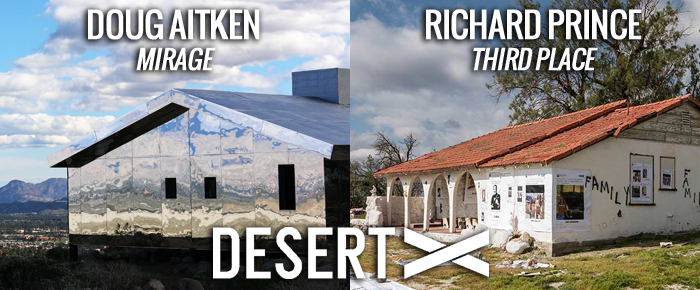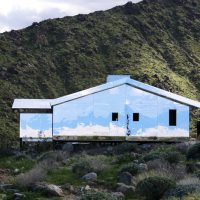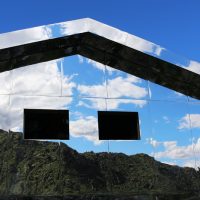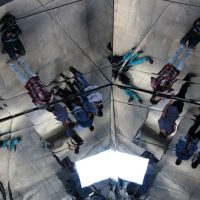
By Angela Romeo
Desert X is site specific and artists from different parts of the world were invited to participate. Doug Aitken is known for his site-specific installations. The Geffen recently mounted an exhibition of his 20-year career for Desert X Aitken created Mirage.
Mirage is a mirrored one story suburban home nestled in the hills overlooking Palm Springs. It sits in the shadow of the ubiquitous Tram Road. Absorbing and reflecting sunlight, mirroring and reflecting the landscape and visitors, the installation is one of the most popular. One can almost image a tourist marker telling the visitor “Best Vista Spot.”
In contrast to the house of mirrors stands Richard Prince’s Third Place. Located in an abandoned home in Desert Hot Springs, the installation features oversized Instagram and Tweets as well as collection of low-end figurines. Taken together the work is dark commentary on the modern family’s acceptable dysfunction.
As Desert X continues, the conversation also remains active. Neville Wakefield, Artistic Director, enjoys the interplay and finds these two installations to be yin and yang.
“There’s an interesting dialogue between the two ideas of houses,” “explains Wakefield. “They are counterpoints. The Aiken piece draws the viewer into the media-scape, a global view The Prince piece takes the viewer in to the psycho-scape, an internal view.”
“Mirage is architecture turned into art. By commingling these two concepts, Aitken creates a new kind of sculpture for the digital age. I see the social media posts from the Mirage as part of the piece. They are a form of digital reflection – part of the house of mirrors.”
“The Mirage sits on the hill in an area undergoing change. Gated communities and new homes surround the installation. Mirage reflects the made-made change as well as the beauty of the surrounding desert.”
It is that location – the changes reflected in the mirrors reflecting the environment that makes it the perfect location for Mirage. It is the same reflection, albeit without the Instagram ready façade, that makes the Desert Hot Springs location the perfect place for Third Place. It is not pretty and does not beg the viewer to pose for postcard-like shots
As Neville pointes out “The Prince installation is a reflection of the psychological landscape. It focuses on decay and a highly dysfunctional family unit. I don’t think the Prince piece is seeking controversy. But like much of his work it creates a volatile reaction. Viewers are drawn to these images because these images have their own life. It is sex, drugs and rock and roll. Third Place is that family we all hope will never be exposed to public scrutiny; an American secret.”
“Viewers are looking for meaning in two very different versions of home. One is awe. The other is shock. Either one can be that viewer at any moment.”
Neville continued, “Art is to stimulate the senses and disarm the viewer. If one sees Mirage as ‘success’ and Third Place as ‘failure’ that is perfect. Art is the last place where one can be a successful failure.”
“Desert X is art furthering a conversation, not a monologue. That these two installations take the viewer to different place is the success of these works.”
That the conversation continues is the success of Desert X.



















































